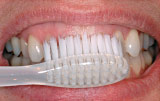Daily Oral Hygiene
Easy Habits For Maintaining Oral Health
(Continued)
The Most Important Lesson You’ll Learn At Your Dentist’s
Hold your toothbrush gently, like a paintbrush, or pen or pencil — not with a fist grip. You may be surprised to know that the motion and pressure needed are minimal, since gum tissues are soft and easily damaged. A modified gentle “scrub” technique is best. Hold the toothbrush bristles — a soft new multi-tufted toothbrush is recommended — at about 45 degrees into the gum line, then gently scrub or wiggle as shown in the pictures to the right.
 |
 |
 |
 |
| Examples of correct bristle placement at the gum line from which to start gentle jiggling, mini-scrub movement. | |
 |
 |
| Floss positioning: Starting gently beneath the gum line, wrapped in a C shape and then moved downward. | |
 |
 |
| Overzealous brushing can cause damage to teeth and gums. Notice the gum recession and the roots are showing. | |
| Photos provided by Dr. Garry A. Rayant | |
Note the different bristle placement for different areas. The adage “practice makes perfect” is true for tooth-brushing as well, so have your dentist or dental hygienist demonstrate the techniques in your own mouth.
A toothbrush should generally last for at least three months, if used correctly. When the bristles become worn or splayed, it’s time for a new one. Worn bristles can cause gum recession and wear of exposed root surfaces. As they say, a new broom sweeps clean.
After you’ve brushed, which should remove most of the plaque, you should then floss once a day or at least every other day. Easy, right? Use the floss by forming a “C” shape by wrapping it around each tooth surface and moving it up and down vertically and gently for 3-4 strokes. Clean each side of the tooth where it contacts the next tooth, and be careful not to jam the floss down between the normally tight tooth contacts.
Brushing And Flossing Tips:
- Learning new or modified behavior takes a little time and practice. Complete brushing may take 2 minutes or more at first and some places may feel awkward to reach in the beginning.
- Brush just once or twice a day, gently and efficiently, getting to all teeth and gum line areas.
- More is not better and can be damaging — don’t scrub hard when brushing, and don’t use a sawing motion when flossing.
- We know most people don’t mind brushing but don’t like flossing — it’s no secret. But remember, over 50% of plaque accumulation occurs in the protected area between the teeth, the site where gum disease and cavities start and progress. Floss once every day or at least every other day.

